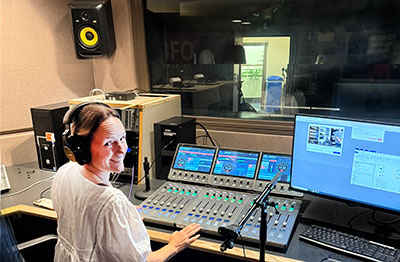Its most recent overhaul has seen US radio and television broadcaster WNED migrate to a full IP infrastructure with multiple Calrec Type R consoles, cores and headless controllers for its 24/7 radio output.
Based in Buffalo, upstate New York, WNED operates three NPR radio stations – WBFO, WNED FM classical music station, and WBFO The Bridge, an adult album-orientated HD Radio station – as well as PBS member TV station WNED-TV, from its busy downtown studios.
 ‘We have main and backup control rooms for all three radio stations,’ says WNED VP of Engineering & Technology Joe Puma, who has overseen engineering for the broadcaster’s radio stations since 1998 and its TV channel since 2005. ‘Each one has a main and backup console with duplicate 12-fader Type Rs, and we also have an 18-fader Type R in our production control room.
‘We have main and backup control rooms for all three radio stations,’ says WNED VP of Engineering & Technology Joe Puma, who has overseen engineering for the broadcaster’s radio stations since 1998 and its TV channel since 2005. ‘Each one has a main and backup console with duplicate 12-fader Type Rs, and we also have an 18-fader Type R in our production control room.
‘All our cores are fitted with 120 DSP channels and are all fully redundant. If the primary control room were ever to fail, the backup runs on a different core, while Type R’s modularity also means we can easily move from one room to another. Because the modules are all PoE we can literally unplug in one room and plug into another.
‘We also operate two headless mixers which uise Calrec Assist to give full remote broadcast capabilities. Buffalo can get a lot of snow and a few years ago we had a horrendous snowstorm that flooded our studio complex. Our previous system did not have any remote capabilities, so it was a real challenge to get people onsite to keep the stations on the air.
‘While the weather hasn’t been bad enough to warrant working from home just yet, we’ve already used Calrec Assist to deliver remote broadcasts from a variety of client locations, and everything works perfectly. The ability to stay on air in a snowstorm was absolutely key to this installation.’
The upgrade was completed in Spring 2025, but WNED has a long history with Calrec, having installed a Calrec Omega console in its TV control room in the 2000s, which Puma says made the decision to work with Calrec on its IP project an easy one to rubber stamp. ‘We’ve used the Omega for almost 20 years and not only has it been 100 per cent reliable, but Calrec’s support has consistently gone above and beyond. We’ve expanded the console over the years, and despite the Omega now being obsolete, Calrec’s support team are always on hand to source parts and help us build additions.
‘That level of support is something you don’t often get nowadays, and licencing for the Type R cores works on a similar basis. All our Type R licenses are perpetual, so we’re not paying for licencing on a year-to-year basis, a model we don’t see from many other vendors.’
The Calrec installation also keeps things super simple for WNED’s operators which, for a broadcaster operating with limited staff numbers, is an important consideration. As well as future-proofing the facility with its interoperable AES67 based backbone, it also plays well with external technologies, such as the station’s Enco DAD radio automation system.
‘The fact that Type R uses a non-proprietary IP system was crucial for us,’ Puma says. ‘Many of the other options we looked at had some sort of proprietary system involved, but with Type R there is nothing layered on top. We’re currently in the process of interfacing it with our Enco DAD system to completely automate the network so that we don’t have to have an external switcher moving the sources around; we want the Type R to do that itself under the control of the workstation.
‘We’re also able to limit Type R’s operator set-up, so it works like our old systems did. I like that our engineers can set the consoles up with presets to keep everything simple for the operators. For example, on an election coverage night, we can just bring up that preset for election coverage and all the routing and mix minuses are all already set up properly.’
‘Stations like WNED are increasingly taking advantage of Type R’s flexible workflows to ensure that they stay on air whatever the future has in store, both technologically and meteorologically.’ says Calrec Regional Sales Manager, Rob Lewis. ‘Type R’s modular approach and adherence to open standards means that it can adapt to a range of needs as well as play nicely with incumbent third-party equipment like automation systems. And in regions like upstate New York, which can be conversely affected by the weather, it ensures that public service broadcasters like WNED fulfil the mission to keep listeners informed.’
More: https://calrec.com

